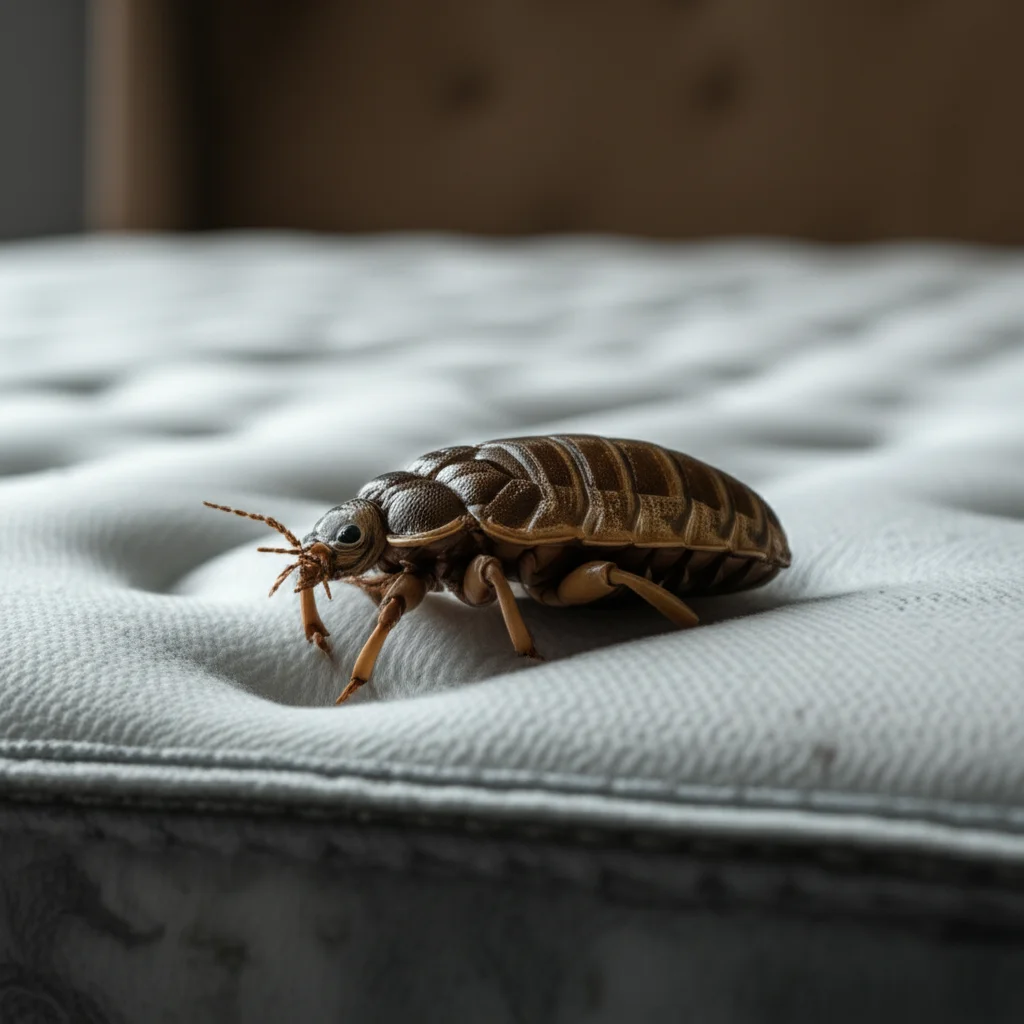· Todd Martin · Pest Control · 20 min read
Can Cat Get Worms From Eating Carpet Beetles

Can Your Cat Get Worms from Carpet Beetles?
You love your cat. You also want to keep your home clean and pest-free. Sometimes, these two desires intersect in unexpected ways. Perhaps you have seen your curious feline friend batting at a tiny insect, then suddenly eating it. This scenario often sparks a common question among pet owners: “Can cat get worms from eating carpet beetles?” It’s a valid concern, as our pets explore their world with their mouths. Understanding the risks involved helps you protect your furry companion. This article explores the link between carpet beetles and feline health. We will cover carpet beetle facts, how cats interact with insects, and the real risks of parasite transmission. Our goal is to give you clear facts about your cat’s safety and well-being.
Takeaway
- Direct Worm Transmission is Unlikely: Carpet beetles do not directly carry or transmit common feline intestinal worms like roundworms or hookworms.
- Indirect Risk from Fleas: Some worms, like tapeworms, require an intermediate host. Fleas, not carpet beetles, are a common intermediate host for tapeworms in cats.
- Focus on General Pest Control: Keep your home clean to reduce all insect populations, including carpet beetles, making it safer for your cat.
- Regular Vet Check-ups: Ensure your cat has routine veterinary visits and receives appropriate deworming treatments as recommended.
- Monitor Your Cat’s Health: Watch for signs of illness or parasites, such as vomiting, diarrhea, weight loss, or changes in appetite.
No, a cat is highly unlikely to get common intestinal worms directly from eating carpet beetles. Carpet beetles do not serve as intermediate hosts for the typical feline parasites like roundworms, hookworms, or whipworms. While cats can get tapeworms from eating infected intermediate hosts, these hosts are usually fleas or rodents, not carpet beetles.
Understanding Carpet Beetles: What Are These Tiny Invaders?
Carpet beetles are common household pests. They are small insects that can cause damage to natural fibers. You might find them in various parts of your home. These beetles belong to the family Dermestidae. They primarily feed on materials like wool, silk, fur, feathers, and dried animal products. This means they can ruin carpets, clothing, and upholstered furniture.
Adult carpet beetles are oval-shaped and quite small, usually only 1/16 to 1/8 inch long. Their color varies by species. Some are black, while others have patterns of white, brown, yellow, or orange scales. The larval stage causes the most damage. These larvae are tiny, hairy, and worm-like in appearance. They are often reddish-brown or yellowish. These larvae feed on the organic materials found in homes. Knowing why do we get carpet beetles helps understand their presence. They often enter homes through open doors, windows, or cracks. They also come in on infested items like plants or furniture. Once inside, they seek out dark, undisturbed areas. These places include under carpets, inside closets, or in attics. They reproduce quickly if conditions are right. A small problem can become a big infestation. Their presence indicates a need for thorough cleaning. Regular vacuuming helps remove eggs and larvae. It is important to address a carpet beetle problem quickly. They do not pose a direct health risk to humans or pets. They do not bite or sting. The main concern is the damage they cause to your belongings. Effective pest management is important for keeping your home safe and intact.
Types of Carpet Beetles
There are several types of carpet beetles you might encounter. Each type has slightly different features. The most common ones include the Varied Carpet Beetle, the Black Carpet Beetle, and the Furniture Carpet Beetle. Each species can infest similar materials.
The Varied Carpet Beetle is perhaps the most common. It has a mottled pattern of white, brown, and yellowish scales. Black Carpet Beetles are uniformly dark brown or black. Furniture Carpet Beetles have a more rounded shape and a distinct pattern. Despite their differences, their feeding habits are similar. All carpet beetle larvae consume keratin. Keratin is a protein found in animal fibers. This explains their attraction to wool carpets, leather, and pet hair. It is important to know which type of beetle you have. This helps in choosing the best removal methods. Identifying them allows for more targeted pest control.
The Feline Instinct: Why Cats Eat Insects
Cats are natural hunters. Their instincts drive them to stalk and capture prey. Even well-fed house cats often chase after bugs. Eating insects is part of their natural behavior. It satisfies their predatory urges. A cat might find a scurrying insect irresistible. The movement triggers their hunting drive.
For a cat, eating an insect is often harmless. Most common household insects do not carry diseases harmful to cats. Spiders, flies, and moths are frequently consumed without issue. Cats enjoy the chase and the novelty of a new “toy.” Sometimes, they do not even eat the insect. They just play with it until it stops moving. Then they lose interest. However, some insects can pose risks. Certain insects may sting or bite. Some can carry parasites or toxins. This is why pet owners worry about what their cats eat. Carpet beetles are small and slow-moving. They do not sting or bite. This makes them easy prey for a curious cat. Your cat might see them as a fun, crunchy snack. They may simply be exploring their environment. They use their mouth as a tool for this exploration. It is a natural part of their world. As pet owners, we try to keep our pets safe. We also understand their natural behaviors.
Common Reasons for Insect Consumption
Cats eat insects for several reasons. Primarily, it is an instinctual behavior. Their ancestors hunted small prey. Modern house cats retain this drive. They get mental stimulation from the hunt. This helps keep them active and engaged. Sometimes, boredom plays a role. A bored cat may seek out any moving object. An insect provides entertainment. It gives them something to focus on.
Another reason is simply curiosity. Cats are naturally inquisitive creatures. They investigate new things. An insect moving across the floor is a new item for investigation. They might bat at it first. Then they might decide to taste it. Occasionally, cats may eat insects for a small amount of extra protein. However, this is not a significant dietary need for a well-fed cat. Most cats get all their nutrients from their regular cat food. The act of eating insects is more about instinct and play than nutrition. They just enjoy the thrill of the chase. This behavior is usually harmless for common insects.
Parasite Transmission: The Link Between Insects and Worms
Parasites are organisms that live on or in another organism, called the host. They get their nutrients from the host. Many types of parasites can infect animals, including cats. Worms are a common type of internal parasite. They live in a cat’s intestines. Understanding how parasites spread is important for pet health. Not all insects transmit parasites. The process is often very specific. A parasite needs a particular intermediate host to complete its life cycle.
For example, a flea can be an intermediate host for tapeworms. If a cat swallows an infected flea, the tapeworm can then develop inside the cat. The flea carries the tapeworm larvae. When the cat grooms itself, it might accidentally ingest fleas. This is a common way for cats to get tapeworms. Another example is mosquitoes. They can transmit heartworm larvae. If an infected mosquito bites a cat, it can pass the larvae into the cat’s bloodstream. These larvae then grow into adult heartworms. This demonstrates a specific pathway for transmission. Not every bug will pass on a worm. It depends on the type of parasite and the type of insect. Most insects do not carry parasites harmful to cats.
How Worms Enter a Cat’s System
Worms can enter a cat’s system in several ways. The most common methods involve ingestion. Cats can swallow worm eggs or larvae. These eggs are often present in contaminated soil or feces. For example, roundworm eggs are passed in the feces of infected animals. If a cat walks through contaminated soil, the eggs can stick to its paws. When the cat grooms itself, it ingests the eggs. This leads to infection.
Another way is through intermediate hosts. As mentioned, fleas carry tapeworm larvae. If a cat eats an infected flea, it can get tapeworms. Rodents can also carry certain worm larvae. If a cat hunts and eats an infected mouse, it could become infected. Mother cats can pass some worms to their kittens. This happens through the placenta before birth or through milk during nursing. Kittens are often born with roundworms. This is why regular deworming is crucial for young cats. Understanding these transmission routes helps in prevention. It allows pet owners to take proper steps. This keeps their cats free from parasites.
Carpet Beetles and Worms: Is There a Direct Risk?
The direct risk of your cat getting worms from eating carpet beetles is extremely low. I want to be clear about this. Carpet beetles are not known to be intermediate hosts for common feline intestinal worms. This includes roundworms, hookworms, whipworms, or the most common tapeworm (Dipylidium caninum). These worms require specific intermediate hosts. Carpet beetles simply do not fit that role. Their biology does not support the life cycle of these parasites.
Some people might confuse carpet beetles with fleas. Fleas are indeed intermediate hosts for a common type of tapeworm in cats. If your cat has fleas and swallows one during grooming, it could get tapeworms. However, carpet beetles are different insects entirely. They do not bite cats or live on their bodies like fleas do. They live in carpets and fabrics. They feed on natural fibers, not blood. So, if your cat eats a carpet beetle, you probably do not need to worry about worm transmission directly from the beetle itself. The risk is virtually nonexistent for internal parasites. This information provides peace of mind for many cat owners. While finding insects in your home is annoying, this particular scenario is not a major health threat for your cat.
Distinguishing Beetles from Worm Carriers
It is important to tell the difference between various insects. This helps understand potential risks. Carpet beetles look different from insects that carry worms. For instance, fleas are tiny, wingless, and jump. They live on pets and feed on blood. They are the primary intermediate host for tapeworms. If you see fleas, you should act quickly. You can read about does flea spray kill carpet beetles, though it’s important to remember they are different pests.
Carpet beetles, on the other hand, are beetles. They have hard wing covers. They walk or fly. They do not jump. They do not live on your cat. They live in your carpet, clothes, and other fabrics. They are mostly harmless to pets. The only real concern is if your cat ingests a large quantity of them. Even then, the risk would be mild stomach upset, not parasitic infection. Other worm carriers include mosquitoes (for heartworm) and sometimes slugs or snails (for lungworms, though less common in indoor cats). Knowing the specific insect helps determine the risk. Most insects are just a crunchy snack for a cat. They are not a pathway for dangerous parasites.
Common Feline Worms: What to Watch For
While carpet beetles are not a risk, other worms certainly are. Cats can get several types of internal parasites. Knowing about these common worms helps you protect your cat. It also helps you spot signs of infection early. Regular deworming and veterinary check-ups are key.
One common type is roundworms. These worms look like spaghetti. They live in the cat’s intestines. Kittens often get roundworms from their mothers. Adult cats can get them by eating infected rodent prey or by ingesting microscopic eggs from contaminated environments. Signs include a pot-bellied appearance, vomiting, diarrhea, and poor growth. Hookworms are another concern. They are small and attach to the intestinal wall. They feed on blood. Hookworm infections can cause anemia, especially in young cats. Symptoms include pale gums, weight loss, and dark, tarry stools. Tapeworms are segmented worms. They live in the intestines. Cats get tapeworms by ingesting an intermediate host. This is typically an infected flea or rodent. You might see small, rice-like segments around your cat’s anus or in their feces. These segments are pieces of the tapeworm. Whipworms are less common in cats than in dogs. They also live in the intestines. Symptoms can include weight loss, chronic diarrhea, or bloody stools. If you notice any of these signs, contact your veterinarian. Early diagnosis and treatment are important for your cat’s health.
Recognizing Symptoms of Parasitic Infection
Spotting symptoms of worms early can prevent serious health problems. Cats can be good at hiding signs of illness. This makes regular observation important. A healthy cat is active and has a good appetite. Changes in these areas can be warning signs.
Common symptoms of internal parasites include:
- Vomiting: This may include actual worms in the vomit.
- Diarrhea: Stools might be soft, watery, or contain blood or mucus.
- Weight loss: Despite eating normally, your cat might lose weight.
- Pot-bellied appearance: This is especially noticeable in kittens with roundworms.
- Changes in appetite: Your cat might eat more or less than usual.
- Dull coat: A healthy coat is shiny. A wormy cat may have a dry, rough coat.
- Lethargy: Your cat might be less active or tired.
- Coughing: Some worms, like roundworms, have a migratory phase through the lungs, which can cause coughing.
- Anal itching: Your cat might scoot its rear on the floor due to irritation from tapeworm segments.
If you see any of these signs, collect a fresh stool sample. Take it to your vet. They can perform a fecal exam. This test identifies worm eggs. Then, they can prescribe the correct deworming medication.
Preventing Pests and Parasites: Protecting Your Cat
Preventing pests is key to protecting your cat from parasites. A clean home environment reduces the chances of your cat encountering harmful insects. This also helps control carpet beetle populations. Integrated pest management is a good approach. This means combining different methods.
Start with regular cleaning. Vacuum your carpets often. This removes food sources for insects. It also removes insect eggs and larvae. Pay attention to hidden areas. These include under furniture and along baseboards. Consider using a vacuum with a strong filter. This traps even tiny particles. You might want to learn how to keep your carpet clean, as a clean carpet is less appealing to pests. Store food in airtight containers. This includes pet food. Pests are attracted to easily accessible food. Repair any cracks or holes in your home’s foundation or walls. These can be entry points for insects. Keep screens on windows and doors in good repair. This prevents flying insects from entering.
Address any moisture issues. Many pests thrive in damp environments. Fix leaky pipes. Ensure proper ventilation in bathrooms and basements. If you find carpet beetles, take steps to eliminate them. Freezing or heating infested items can kill them. For example, does heat kill carpet beetles? Yes, extreme heat can kill them. Regular inspections are also helpful. Check pet bedding, rugs, and closets for signs of pests. Catching an infestation early makes it easier to manage.
Maintaining a Clean Home Environment
A clean home is a happy home for both you and your cat. It also acts as the first line of defense against pests. Regularly vacuuming is perhaps the most important step. I try to vacuum my carpets a few times a week. This picks up pet hair, dander, and food crumbs. These are all potential food sources for carpet beetles and other insects. Focus on areas where carpet beetles like to hide. This includes under furniture, along baseboards, and in dark corners.
Beyond vacuuming, consider steam cleaning your carpets periodically. This can kill eggs and larvae that vacuuming might miss. Keeping your home tidy also means decluttering. Pests love clutter. They hide in piles of clothes, boxes, and old newspapers. Store seasonal clothing in airtight bags or containers. This protects them from beetle damage. It also removes hiding spots. Pay attention to areas where pet hair collects. Pet hair is a favorite food source for carpet beetle larvae. Regular brushing of your cat helps reduce shed hair around the house. This also lessens the food source. Good home hygiene goes a long way. It stops pests from settling in. This makes your living space healthier for everyone.
Routine Veterinary Care and Deworming
Routine veterinary care is crucial for parasite prevention. Your veterinarian is your best resource. They can recommend a deworming schedule. This schedule depends on your cat’s age, lifestyle, and risk factors. Kittens typically need deworming more often. They are more susceptible to worms. Adult cats may need deworming annually or semi-annually. This depends on their exposure to the outdoors and other animals.
During your cat’s annual check-up, your vet will usually perform a fecal exam. This test checks for worm eggs. It identifies if your cat has an active worm infection. Even if your cat shows no symptoms, they could still have worms. Some parasitic infections are asymptomatic in early stages. Your vet can also advise on flea prevention. Flea control is essential for preventing tapeworms. There are many effective flea prevention products available. These include topical treatments, oral medications, and collars. Discuss the best option for your cat with your vet. Following their advice helps keep your cat free from internal and external parasites. This preventative approach is the most effective way to ensure long-term health.
When to See the Vet: Recognizing Warning Signs
Knowing when to call the vet is important. While eating a carpet beetle is usually harmless, other symptoms might indicate a problem. Always observe your cat closely. Any change in behavior or physical condition warrants attention. I always tell my friends to trust their instincts about their pets. If something feels off, it probably is.
For example, if your cat eats a beetle and then immediately starts vomiting repeatedly, this could be a sign of irritation. This is not necessarily worms. It might be simple indigestion. However, if your cat exhibits any of the general worm symptoms we discussed, like persistent diarrhea, unexplained weight loss, or a dull coat, seek veterinary help. Do not wait for severe symptoms. Early intervention often leads to better outcomes. Also, if you notice any unusual segments resembling rice grains around your cat’s anus or in their litter box, that is a strong indicator of tapeworms. These require specific treatment. When in doubt, a quick call or visit to your veterinarian provides peace of mind. They are equipped to diagnose and treat any underlying issues your cat may have. They can also offer guidance on preventative measures.
Preparing for a Vet Visit
When you need to take your cat to the vet, preparation helps. Gather any relevant information beforehand. This makes the visit more efficient. Think about your cat’s recent behaviors.
Consider these points:
- Symptom details: Note down when symptoms started. Describe their frequency and severity. For example, “My cat has vomited twice a day for the past three days.”
- Dietary changes: Has your cat’s food changed recently? Has their appetite increased or decreased?
- Exposure: Has your cat been outdoors more? Has it interacted with new animals? Did it eat anything unusual? (Like a carpet beetle, in this context).
- Medications: List any current medications or supplements your cat takes.
- Litter box habits: Note changes in urination or defecation. Take a fresh stool sample if possible. Place it in a clean container or a plastic bag. This sample helps the vet check for parasites.
- Bring your cat’s health records: This gives the vet a complete history.
Being prepared helps your vet make an accurate diagnosis. It also ensures your cat gets the best care possible. Do not hesitate to ask questions. This helps you understand your cat’s condition and treatment plan.
Home Management of Carpet Beetles: A Pet-Safe Approach
Managing carpet beetles at home is important. You want to do it safely for your cat. Harsh chemicals can pose a risk to pets. There are many pet-friendly options available. A proactive approach is best. This reduces the need for strong pesticides. My goal is always to keep my home healthy for my pet.
Start with physical removal methods. Regular, thorough vacuuming is essential. Vacuum all carpets, rugs, and upholstered furniture. Pay attention to edges, cracks, and crevices. These are hiding spots for beetles and larvae. Empty the vacuum cleaner bag or canister outdoors immediately. This prevents re-infestation. Wash infested items in hot water if possible. Clothing, bedding, and small rugs can often go into a washing machine. High heat kills beetles and larvae. You can also freeze small items. Place them in a sealed plastic bag. Put them in the freezer for several days. This is effective for delicate items.
For larger infestations, consider non-toxic traps. Sticky traps can catch adult beetles. Diatomaceous earth is another option. It is a natural powder made from fossilized algae. It works by dehydrating insects. Sprinkle a thin layer in affected areas. Make sure it is food-grade if your cat might walk through it. Always use according to package directions. It is generally safe for pets once settled. Reduce their entry points. Seal cracks around windows and doors. Use screens on windows and vents. These steps help prevent beetles from entering your home. If the problem persists, consult a professional pest control service. Choose one that offers pet-safe treatment options. Effective pest management protects your home and your cat.
Natural Repellents and Preventative Measures
There are several natural ways to deter carpet beetles. These methods are generally safe for pets. They focus on making your home less attractive to beetles. Keeping your home clean is always the first step. Beetles are attracted to dirt and natural fibers.
One simple method is using cedar. Cedar wood and cedar oil have a natural repellent effect on many insects, including beetles. You can place cedar blocks or sachets in closets and drawers. Ensure your cat does not chew on them. Essential oils like lavender, peppermint, and eucalyptus also deter insects. However, be very careful with essential oils around cats. Many are toxic to felines. Diffuse them in well-ventilated areas. Do not apply them directly to surfaces your cat touches. Always research specific oils for pet safety. Avoid direct contact.
Another preventative measure is regular airing out of items. Sunning rugs and blankets can deter pests. Beetles prefer dark, undisturbed places. Sunlight and fresh air make these areas less appealing. Store natural fiber items properly. Use airtight containers or garment bags. This prevents beetles from accessing them. Inspect second-hand furniture and clothing before bringing them into your home. They can introduce pests. By combining cleanliness with natural deterrents, you create a less inviting environment for carpet beetles. This keeps your home more secure and your cat safer.
Conclusion: Ensuring Your Cat’s Safety and Well-being
Understanding your cat’s behavior and potential risks is part of being a responsible pet owner. We have explored the question: “Can cat get worms from eating carpet beetles?” The good news is that carpet beetles do not directly transmit common feline intestinal worms. This should ease your mind if you have seen your cat snack on one of these household pests. The primary concern with carpet beetles is property damage, not direct parasite transmission to your cat.
While carpet beetles themselves are not a direct threat for worms, other risks exist. Fleas are a known intermediate host for tapeworms, and contaminated environments can harbor roundworm eggs. Therefore, maintaining a clean home environment is paramount. Regular vacuuming, addressing clutter, and proper storage of natural fibers help control not only carpet beetles but also other pests that could indirectly affect your cat’s health. Most importantly, consistently follow your veterinarian’s recommendations for routine check-ups and deworming. They can provide tailored advice and ensure your beloved feline friend remains healthy and parasite-free. By staying informed and proactive, you can ensure your cat enjoys a safe and happy life, free from the worry of worms, regardless of their occasional insect explorations. Take these steps today to keep your furry companion thriving.





